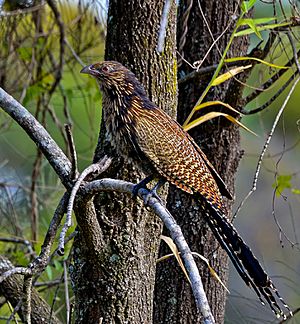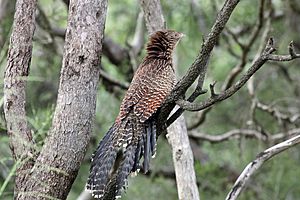Pheasant coucal facts for kids
Quick facts for kids Pheasant coucal |
|
|---|---|
 |
|
| In Queensland, Australia | |
| Conservation status | |
| Scientific classification | |
| Genus: |
Centropus
|
| Species: |
phasianinus
|
| Synonyms | |
|
Cuculus phasianinus Latham |
|
The pheasant coucal (Centropus phasianinus) is a special type of cuckoo bird. It belongs to the Cuculidae family. You can find this bird in places like Australia, Timor, and New Guinea.
These birds love to live in warm, wet places. Their favorite homes are lowland forests and mangrove forests. They have also learned to live well in sugar cane fields in northern Australia. What makes the pheasant coucal unique is how it raises its babies. Unlike most other cuckoos, it builds its own nest and takes care of its young. It does not lay its eggs in other birds' nests.
Contents
About the Pheasant Coucal's Name and Family
Scientists give every animal a special name. This helps them organize and study living things. The pheasant coucal was first described in 1801. An expert named John Latham gave it the scientific name Cuculus phasianinus. He based his description on a drawing by Thomas Watling.
There are six different types, or subspecies, of pheasant coucals. Two of these live in Australia. One type, called phasianinus, lives in the south. The other, melanurus, lives in the north and is larger. The mui subspecies lives in eastern Timor. It has unique white feathers on its head and chest. The other three subspecies live in New Guinea. They tend to have darker feathers.
What Does the Pheasant Coucal Look Like?
The pheasant coucal is a big, strong bird. It can be 50 to 70 centimeters (20 to 28 inches) long. It looks a bit like a pheasant because it spends a lot of time on the ground.
When it's breeding season, the bird's head, neck, and belly are black. Its wings are a mix of chestnut and black stripes. It also has a long tail with black, brown, and cream stripes. After the breeding season, its black feathers change. They become a chestnut color with white streaks.
The pheasant coucal has different calls. In summer, it makes a low sound like 'boop boop boop' that goes down in pitch. In winter, it makes a sharp, hissing sound.
Where the Pheasant Coucal Lives
You can find the pheasant coucal in eastern and northern Australia. It lives from the south coast of New South Wales all the way up to Cape York. It also lives across northern Australia to the Pilbara region. Beyond Australia, it is found in eastern Timor and the lowlands of New Guinea.
These birds like places with thick plants and bushes. They often live in forests with dense understory (plants growing under trees). They also like tall grasses in grasslands or swampy areas. You might even spot them in sugar cane fields or patches of weeds like blackberry.
What the Pheasant Coucal Eats
The pheasant coucal is mostly a meat-eater. It hunts and eats small animals. Its diet includes small reptiles and amphibians. It also eats bird eggs and young birds. Sometimes, it catches small mammals and large insects.
Reproduction and Life Cycle
The pheasant coucal builds a messy, bowl-shaped nest. It uses grasses and leaves to make its home. The nest is usually hidden in tall grass or bushes. The bird often pulls plant stems over the nest to create a roof.
A female pheasant coucal lays two to five white, oval-shaped eggs. Each egg is about 38 by 29 millimeters in size. The eggs hatch after about 15 days. The young birds stay in the nest for another 13 days. Interestingly, the male pheasant coucal does most of the work. He builds the nest, sits on the eggs to keep them warm, and feeds the baby birds.
See also
 In Spanish: Cucal faisán para niños
In Spanish: Cucal faisán para niños



